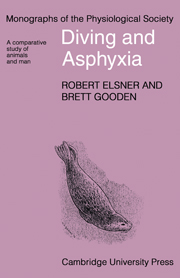Summary
We have assembled in this monograph our views regarding the physiological events that are collectively described as the diving response. The emphasis is mostly but not exclusively mammalian, as is appropriate to our experience. Adaptations to diving asphyxia were originally identified only in animals that live in aquatic habitats. It has since become evident that the natural divers display a well-developed variation of a more general defence against asphyxia. Much can be learned about asphyxia and related cardiovascular and metabolic responses from field and laboratory studies of diving animals, the natural specialists whose reactions yield conveniently to experimental manipulation. An even broader perspective suggests that the species so tolerant of diving asphyxia are part of a continuum of animals which respond to hostile environments and disturbances of homeostasis by strategic retreat into conditions of depressed metabolism. Knowledge derived from the study of diving animals contributes to biological understanding and also holds promise for practical applications to clinical medicine.
We are much in debt to colleagues and students for suggestions and discussions, but our failures in explanation and judgement are our own responsibility. We owe special and personal gratitude to those two pioneers in this field, Laurence Irving and P. F. Scholander, both recently deceased, who set high standards some forty years ago for deciphering the mysteries governing the adaptations of diving mammals and birds. Whatever good comes of this publication is dedicated to them.
- Type
- Chapter
- Information
- Diving and AsphyxiaA Comparative Study of Animals and Man, pp. ix - xPublisher: Cambridge University PressPrint publication year: 1983



